Good Earth Tours Review
The trip was everything that we were expecting and we were very satisfied with Abdul and Good Earth. Abdul was just the right guide for us as Sam and I are not very chatty, so Abdul didn't have to keep up a continuous stream of banter to entertain us. When we asked to change the itinerary so that we could go on early morning game drive he was very accommodating.
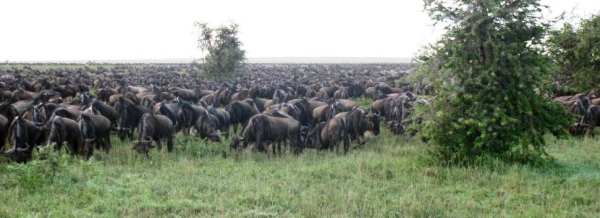
Day 1
Sam and I arrive in Tanzania at Kilimanjaro Airport which is halfway between Arusha and Moshi. Mt Kilimanjaro is to the north but its summit is hidden in clouds. It being early April, the rainy season is near, but not yet. The ground is still very dry, the dust devils are tall and brown and are not billowy at all, they look more like tan columns rising from the dry plain.
We are staying at the Jacaranda Hotel in Arusha (quite nice, food was excellent with huge portions).
It is clearly the low season, as there are few guests other than Sam and me. Babu met us at the gate, carried our bags to the room, and stands next to our dining table in the lush garden that surrounds the hotel. He has promptly taught us the rudimentary Swahili words that we will need to get by:
Cariboo - You are welcome
Jambo - Hello
Qwaherie - Goodbye
Asante - Thank you
Serra - Very much
Kwa - for
The driver that picked us up from the airport, Richard, who also helped me to shop for a pair of sunglasses and a nice Tanzanite stone for Trudie taught me M'zungu - white man, saying that all the merchants have a M'zungu price and the real price.
Richard is of the HeHe tribe of southern Tanzania and has never traveled out of the country. Babu is of the Samba tribe in the area of Lake Tarangire, also has never left Tanzania.
Babu gets very animated as he tells me of the time when he worked on hunting safaris in the Ngorongoro area. He tells me he is most frightened of the cape buffalo, because once shot the cape buffalo might lie down as though dead, then when the hunter approaches, the cape buffalo will jump up and charge the hunter, or the guide, or the porter; as Babu learned the hard way.
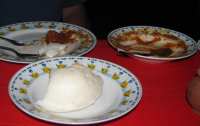 I have requested ugali with my meal. I've never eaten it before. A Kenyan woman that I know said that in Kenya, a woman cannot have a husband if she cannot make proper ugali. She would also be a disgrace to her entire family. Babu says that if he does not have ugali within three days, he loses power.
I have requested ugali with my meal. I've never eaten it before. A Kenyan woman that I know said that in Kenya, a woman cannot have a husband if she cannot make proper ugali. She would also be a disgrace to her entire family. Babu says that if he does not have ugali within three days, he loses power.
At the Jacaranda, we sit out in the garden. The Kilimanjaro Beer comes ice cold with a frosted mug and is very good. The kitchen is outdoors and off to one side of where we sit. The smells are fantastic coming from the charcoal grill, and the African music makes for an ideal atmosphere to end the day.
It turns out that ugali is Swahili for grits but the grits I grew up with make a puddle in the bowl. Ugali makes more of a pillow in the bowl. It is hard to imagine in our world where our daughter's matrimonial success depends on her ability to cook grits.
Day 2
Abdul, our Good Earth Tours guide, picked us up at 0800. We had a fine breakfast of scrambled eggs, toast, and jackfruit jam. The Tanzanian coffee, grown locally, is dark and rich just like the people.
The sky is cloudy and dark and looks like rain. Sam and I are the only clients on this safari so we get a private safari at group safari price. As we leave Arusha, we pass by farms and coffee plantations. There are people in the fields hand hoeing the ground to plant corn. They are working quickly to beat the rains.
Habari ganni - How are you?
Misuri - I am fine.
Abdul is of the Nerambe Tribe of central Tanzania, around Dodombo, Tanzania's new capital.
The landscape is becoming more hilly as we head towards Lake Manyara, west of Arusha. The road is paved and in good shape. Every few kilometers we pass a bicyclist (the Lance Armstrong kind) going the same way.
The Massai children with the traditional Massai blanket over their shoulders and always a stick in hand tend their cattle near the road. We haven't taken one picture yet. Abdul must be wondering what is wrong with us.
The dirt is more red in color as we near the Great Rift Valley. This area has received rain and is very green and lush. What I appreciate most, as we drive along is a complete lack, other than the paved road, of any sign of modernity - no billboards, road signs, street lights, power lines, just the road and the vast rolling hills.
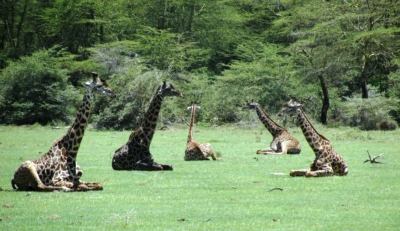 Our first wild animal sighting is a small herd of zebras followed by a herd of wildebeest some 100 meters off the road. Now some giraffes, then cattle and Massai. We are down on the valley floor proper. Ahead are the shear fault scarps that mark the eastern boundary of the rift.
Our first wild animal sighting is a small herd of zebras followed by a herd of wildebeest some 100 meters off the road. Now some giraffes, then cattle and Massai. We are down on the valley floor proper. Ahead are the shear fault scarps that mark the eastern boundary of the rift.
In the town of Mosquito River, we drive slowly to avoid the cattle, goats and pedestrians. Several of the locals recognize me as American and yell out, "Obama! Obama!"
Many blue monkeys guard the entrance of the Manyara National Park.
Lake Manyara is a shallow, alkaline lake fed by numerous natural springs. Along the edge of the lake is flat grassland with the occasional catchment which provides a ready source of water for the numerous zebras, wildebeests, and especially the hippos. Up from the grassy pastures it looks like the hill country of central Texas, with scrub brush, acacia trees and strewn with boulders. The giraffes favor this area.
Higher up, the vegetation gets really thick and that is what the elephants like because they feed continuously - up to 14 hours per day. We can often smell the elephants before we see them. An elephant turd is about the size of a desktop computer.
The baboons also like the thick forest. There may be 50-60 in each troop: big ones, tall ones, short ones, skinny ones.
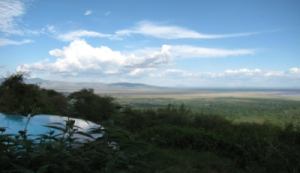 The Lake Manyara Serena Lodge is built up high on the edge of the fault scarp. It has a fantastic view of Lake Manyara and the Great Riff Valley.
The Lake Manyara Serena Lodge is built up high on the edge of the fault scarp. It has a fantastic view of Lake Manyara and the Great Riff Valley.
I sit at the poolside bar, sipping an ice cold Kilimanjaro (without the frosted mug that Babu provided). With my binoculars, I can scan the grassy pastures below for elephants and wildebeest.
Dinner was quite good but the white tablecloth, candle, and porch dining was waaay too romantic for Sam and I.
Day 3
Mambo vipe - How are things?
Pua - Cool !
My waiter last night in the bar was Benjamin of the Iraqwa Tribe. He told me the story of how Idi Amin tried to annex Lake Victoria away from Tanzania. He said that Amin was a very bad man. He would round up all the old people, crippled people, put them on a boat and dump them alive into Lake Victoria to be eaten by the crocodiles.
We are driving now toward the Serengeti, passing the Ngorongoro on the way. The sky is filled with heavy dark clouds but still no rain.
As we make our way up in to the highlands it is much more agricultural as the soil is a rich volcanic red. This area got rain last night, now there is a layer of sticky red mud on the roadway. It reminds me of south Louisiana during the sugarcane harvest.
There are many dark Africans walking or riding their bikes along the side of the road, everyone burdened to some degree. One woman balances a 5 gallon bucket on her head with no hands. A man walks with two long fresh cut sisal trunks on his shoulder.
The country side is hilly, so they push their bicycles up the one side of the hill then go flying down the other side, sometimes with two or three people on the one bike. Only twice have I seen someone using beasts of burden that are not human. One, a small cart, pulled slowly up the hill by two skinny Brahma cows, and the second a team of 4 Brahma cattle dragging a plow guided by one skinny African and three Africans whipping the cows.
The hard packed red mud road leading up to the Ngorongoro Crater Rim takes us through a dense rain forest; the mountain is big enough that it makes its own weather. The clouds are low and rolling in on top of us. We pass a troop of baboons and the phrase "Gorillas in the Mist" pops into my head.
We stop to look down into the crater and the view is fantastic; the crater is filled with herds of wildebeest, zebra, a pair of elephants and walking not far away, a pair of hominids. This is Massai Land and they roam as freely as the wild animals do. It's neat to see the Massai tending their cattle herd and nearby are gazelles and giraffes.
We stop at a Massai encampment where maybe 50 people live. They sing and dance for us. Lucas introduces himself as our guide and says we are free to take 1000 pictures and ask 100 questions.
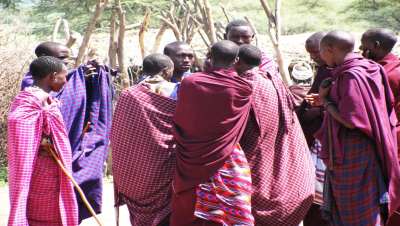 We are taken into the low, cattle dung covered hut that is home to Kinshera, his wife, and two children. He and his wife sleep in separate beds except, he says, when he is powerful. Kinshera brags that he killed a lion only last month. I believe him, but get the feeling that it was last year or the year before.
We are taken into the low, cattle dung covered hut that is home to Kinshera, his wife, and two children. He and his wife sleep in separate beds except, he says, when he is powerful. Kinshera brags that he killed a lion only last month. I believe him, but get the feeling that it was last year or the year before.
We go down to the kindergarten and meet the children. They all must 'high 5' Sam.
Then we go to the "shop" which is just a spot where they hang their hand-made bracelets and necklaces on the acacia branch fence that protects their sheep and goats from the lions. I buy a handful of bracelets for Hannah and one of copper for me. Sam wants one of their hunting spears. The haggling starts at $50 US, it seems for a minute it will stop at 40, but Abdul steps in and gets it for $35 - a very good M'zungu price.
During the shopping, Sam and I are surrounded tightly by the Massai; old ones, young ones, boy ones, girl ones, all shouting in the Massai tongue. They hang necklaces on me, force bracelets around my wrists, and shake their war clubs in my face. Then, when the spear deal is done, everyone goes quietly back to what they were doing.
We leave the Massai Land of the Ngorongoro. The land flattens and is much drier. We begin to see small groups of Grant's then Thompson's gazelles. The Hyenas we see are mangy and dirty but quite large.
We have lunch at Naabi Hill which is a solitary granite mound jutting up from the plain. After lunch, Sam and I take a trail up to the high point.
I am up ahead and I hear Sam, "Whoa, dad!" And I ask, "What is it?" Sam says, "Are you blind? Look behind you." And there, about twenty meters away is an ivory tusked behemoth casually dining on the undergrowth. He is accompanied by four other smaller elephants. Our first close encounter!
We spend the night at the Serena Lodge after seeing no fewer than 10 very lazy lions. They were up in the sausage trees which provide lots of shade. This is mid-afternoon and very hot so I don't blame them for not providing more entertainment for us.
Day 4
I ask Abdul if we can go on an early morning game drive. I am hoping to see the lions up and about. We collect our boxed breakfasts from the kitchen and leave out around six am. The morning is cool and overcast. Sam sacks out on the back seat under a red and black Massai blanket compliments of our fine guide Abdul. We promise Sam we will wake him if we see something good.
This terrain reminds me a lot of central Texas, in and around Enchanted Rock. We are up in the hilly part, low scrub brush with a few trees. Not seeing much other than hyenas, warthogs, and a few waterbucks.
Abdul makes his way down on to the flat plains. We are still not seeing anything. Then I point out a dark area on the horizon and ask, "Is that wildebeests?" Abdul says, "I think you should wake Sam, this is something good."
Slowly we ease the Land Cruiser forward as we top a small hill. It becomes apparent that this is something good - The Migration. Hundreds of thousands of wildebeests and zebra packed together. All moving as one.
Adbul cuts the engine and slowly but steadily the leading edge of the migration bends around our vehicle. It's amazing.
This is one of those seldom seen sights that one marks in his consciousness, like seeing the Mona Lisa; not the most beautiful painting, but exceptionally rare. We have our breakfast here, while the herd splits to go past us to the north where they have always gone this time of year.
We are satisfied with our game viewing this morning. The Serengeti is a place of bigs. Big animals, big plains, big herds, and big sky.
I like game spotting. I've spent my hours driving dirt roads in Texas looking for deer, turkey, and wild hogs. The Serengeti is game spotting on steroids. I was disappointed with myself yesterday. I wanted to be the first in our car to spot a lion, but Abdul beat me to it - seven times! I'm just getting old, I guess.
The lions were sleeping about ten metres from the freshly killed and half eaten Cape Buffalo. There were four of them and one cub. All their bellies were full and round. It was only 8:00 am when we spotted them and already the vultures are gathering overhead.
A lone hyena approached from the south, downwind of the kill and got within 20 metres before his sense of reason overcame the hunger in his stomach and he went off and laid down a hundred metres away. Later, a pair of hyenas came close enough to alert the lions, but four against 2 was still not the odds they needed.
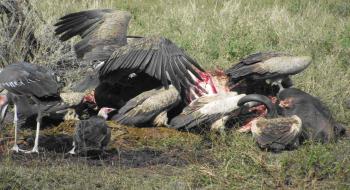 When the sun came up and dissolved the shade the lions were enjoying on the ground, one by one, slowly and deliberately, they sought shelter from the heat in the branches of a nearby acacia tree. The vultures saw this as their cue. They swooped down from their perches in the dead tree next to us and began a noisy feeding frenzy that was quite violent to watch.
When the sun came up and dissolved the shade the lions were enjoying on the ground, one by one, slowly and deliberately, they sought shelter from the heat in the branches of a nearby acacia tree. The vultures saw this as their cue. They swooped down from their perches in the dead tree next to us and began a noisy feeding frenzy that was quite violent to watch.
Abdul fired up the Land Cruiser and we moved on about 500 metres before seeing two juvenile male lions right next to the road. Dried blood still streaked their jowls. Other trucks begin to show up so we decide to leave.
Abdul takes a roundabout way back to the lodge. Sam and I felt the morning had been quite successful so far, then Abdul spots a leopard sleeping high up in an acacia tree. The leopard sighting is number four for us of the Big Five - elephant, buffalo, lion, leopard, and rhino. If we are lucky we will see rhino in the Ngorongoro Crater tomorrow.
We return to Serengeti Serena Lodge to wash up and rest. It rains while we are having our lunch. Later, on the way to the Hippo Pool, the elephants we see have had their mud cakes removed by the rain. They look more majestic when clean.
The Hippo Pool is more a cesspool. Over 100 hippos; big ones, small ones, and fat ones are all bathing together in the same pool without ever changing the water. The hippos browse all night on dry land. By day they return to the cooling waters of the pool.
Back to the Serena Lodge for dinner and live entertainment of music and acrobatics.
We have had two days of bouncing around in the truck and decide to reward ourselves with a massage. The Lodge has a canvas tent set up on the bluff that looks out over the Serengeti and Mercei, a lovely young girl from Kenya with small but very strong hands gives a wonderful massage to the night sounds of Africa.
At the Serena Lodge, after dark if you want to walk from your room to the restaurant, you first call the front desk and they send a seasoned, but retired, game ranger to your hut to escort you so you don't get attacked by animals on your way - Tres' cool.
Day 5
We game drive our way out of the Serengeti, heading southeast to Ngorongoro - Massai Land. On our way, we encounter another large herd of wildebeest and zebras.
We watch as two lions, a female and a young male, stalk up to a small group away from the main herd. The lions move slowly and close to within 100 metres, but the zebras have spotted them. The lions get a bit closer and the zebras sound the alarm, stampeding the small herd back towards the main herd.
It's too late in the morning for these lions to give chase, they would spend too much energy and may not catch anything at all. So they lie down beneath an acacia tree and wait for a better opportunity. With this many wildebeest coming their way they will have much better prospects if they are patient.
We leave the uplands of the Serengeti to the central area which is a broad flat, treeless plain with the occasional, erratically distributed kopjes. Kopjes are erosional remnants of ancient granite intrusions, essentially a pile of boulders. Rain water collects in and around the boulders so trees and bushes grow there.
Abdul spots several different lions up high on top the boulders, but usually under shade of some kind and very difficult to see. One of the other drivers tells us of a cheetah nearby so we head that way. The cheetah doesn't like our company and soon moves in to thick brush to sleep the day.
We arrive at the Serengeti Lodge - Ngorongoro after a long bumpy ride across the Serengeti. The view from the Lodge is spectacular from everywhere.
The storm clouds have rolled in over the crater and are dumping isolated showers here and there. As day becomes night, the flashes of lightening reflect brilliantly off the surface of the central crater lake.
I enjoy a double shot of Johnny Walker to the sounds of the Massai entertainers who leap high in the air to a background sound of aboriginal chanting. The jump seems random to me, but they are black and I am white so I assume they are keeping to a rhythm that only the Massai know.
We begin our game drive in the crater at 6:30 am. As we descend on to the crater floor, we see the scattered wildebeest, gazelles, and elephants against the backdrop of the central lake, I can't relate to this place the way I did the Serengeti and Manyara. This place has a primal, Jurassic feel to it. The animals want for nothing. This time of year, they have plenty of fresh water and green grass, the carnivores are fat as well.
We stop to have our breakfast at a large, clear, hippo pool on the extreme south end of the crater floor. We sit under an ancient sausage tree near the water and have to fend off the bright yellow weaver birds who literally steal your food on the way to your mouth.
It's a peaceful place and I go to the truck to get my journal. As I turn away from the truck, off to my left about 50 metres and off to Sam and Abdul's right at about 30 metres are four lions coming up from the edge of the water. A small cub is with them. Adbul sights a young male about seventy yards away in the tall grass. We all ease back to the truck.
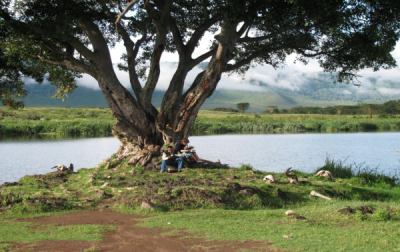 A large male, huge black mane comes down over the hill, marking his territory every 20 paces or so. You can tell he wants to get a little bit from one of the lionesses but she isn't having any of it. The lioness of his attention gets up and heads away from the hippo pool, out on to the open plain. All the other lions follow her very slowly, very deliberately.
A large male, huge black mane comes down over the hill, marking his territory every 20 paces or so. You can tell he wants to get a little bit from one of the lionesses but she isn't having any of it. The lioness of his attention gets up and heads away from the hippo pool, out on to the open plain. All the other lions follow her very slowly, very deliberately.
Adbul fires up the truck and we follow them just as slowly. When we get up on the plain we see two other big males joining the group that we are following. Eventually we are surrounded by 10 lions including the cub.
We take pictures and video until our batteries run low. The word is out about our find. Other trucks start to show up. It's time for us to move on.
The pressure is on Adbul to fill out our big five. There aren't many rhinos in the crater, less than twenty. They had been poached almost to extinction but are now slowly coming back. Sam and I have become jaded, the large herds of zebra, wildebeest, cape buffalo and warthogs no longer excite us. They don't excite Abdul either so he is driving more quickly than the other safari trucks. Since he was the one who sited the pride of lions and generously shared it with the other drivers via the CB radio - they owe him. If anyone spots a rhino, they will certainly call Abdul.
We head out of the crater intending to pass through the Ledai Forest which is home to several large, old elephants.
I've been trying hard all week to spot something of interest before Abdul. On a grassy plain before entering the forest, I see some grey lumps off to the right about 300 metres. "What's that over there, Abdul?" He looks up and yells, "Rhinos!" - finally I see something before he does.
He stops the truck and we spot six rhinos out there, some are lying down and the others are walking away from us. They are all caked in dried grey mud. That's number five. Abdul can relax now, and Sam and I are tired. We've seen enough. It's time to leave the crater and head back to Arusha.
A big dark cloud is dumping rain into the north end of the crater. On the way back to Arusha we get hammered by rain. It hits so quickly that the Massai herdsmen can only hunker down under their blankets. The rainy season is here.
Back in Arusha, it is market day. The streets are packed with people, cars, trucks, push carts and bicycles.
We arrive back at the Jacaranda and say our goodbyes to Adbul. We have traveled many miles together and will miss his company.
Babu is waiting to accept us back in to his custody. When I get to the bar he has an ice cold Kilimanjaro beer with a frosted glass mug waiting for me. He wants to know all about our trip in detail. Even though I am sitting at the bar and the lovely Khanna should be serving me, Babu does not allow it. He brings me a fresh beer and frosted mug whenever I get low. Babu and I discuss the evening meal plan. Ugali of course, with a well seasoned grilled beef and Swahili salad. Sam has the chicken wings and fries.
Unaitwa nani? What is your name?
Unatoka Wapi? Where do you come from?
Nzuri - good
Mizuri - Beautiful
Mambo - hello
Pua - good, cool
Hakuna matata - no problem
Nakupenda - I love/like you
Una to kaei Arusha - I am from Arusha
Shinishiling oapi - How much is this?
Mzungu - white man
Neema - grace
This is our last day in Tanzania and I let Sam sleep in. I am the first to the restaurant for breakfast which is simple; eggs, toast and an assortment of homemade jams including jackfruit and green tomato jam, but I am here for the coffee - rich and dark with warm, whole-fat milk and a teaspoon of brown, unrefined sugar. In all of the hotels so far, I have had to ask for brown sugar. At the Jacaranda, you have to ask for the white sugar.
Richard picks us up from the hotel just before lunch. We drive past the clock tower roundabout which marks the halfway point between Cairo, Egypt and Cape Town, South Africa. We stop to buy some coffee beans to take back to Dubai. Then at Sam's request, we stop at McMoody's for lunch. McMoody's is the only place in Arusha that makes hamburgers and they are very good.
| Safari Location: | Lake Manyara, the Serengeti and Ngorongoro Crater in Tanzania. |
| Safari Company Used: | Good Earth Tours - More Good Earth Tours review & safari ratings » |
| Duration: | 3-7 April 2009 (5 days) |
| Traveller Details: | Kenneth Bryant, (Dubai, UAE) |
| Rates & Availability: | Plan your own safari - Make an enquiry |
More Serengeti Safari Reviews
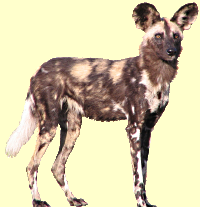
Back to the safari Tanzania reviews page or top


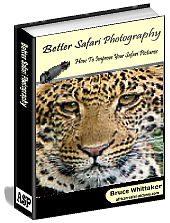
New! Comments
Have your say about what you just read! Leave me a comment in the box below.